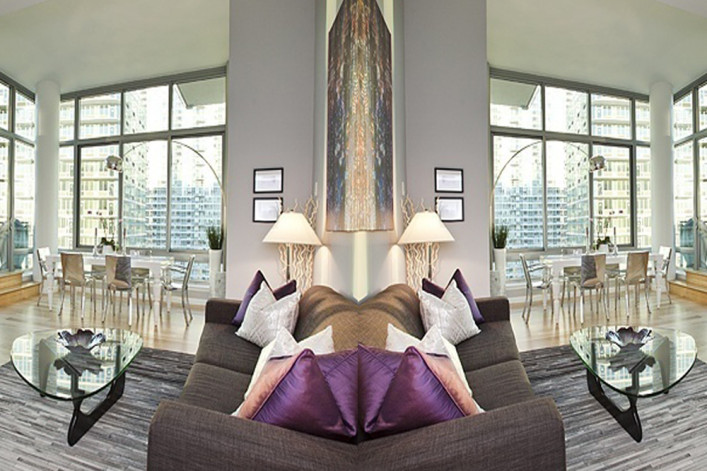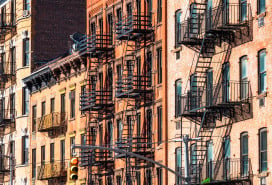6 ways to outdo your neighbor when you're both selling your apartments

In medium to large apartment buildings, it’s not uncommon to find two, four or more units for sale in the same building at the same time. So how do you get the best price for your co-op or condo when there are other similar units for sale?
From making modest updates to telling a story with staging, here are tips from brokers on making your unit the “belle of the ball,” as Holly Sose, an agent with City Connections, put it.
Spotlight the competition
If you’re in unit 7A and hitting the market after 8A, note the differences between the apartments, both in your listing and marketing materials and during showings, recommends Mary Lou Currier, an agent with Bond New York.
If 8A is completely renovated and up for the same price as 7A, which is not renovated, there’s only one thing to do.
“Market the apartment as an opportunity… something that needs TLC. Or needs work,” she says, adding some buyers may want to make changes on their own.
If you're competing against a unit that is similarly sized (or priced) but with a different layout, another option is to emphasize the potential for more rooms, says Yair Tavivian, co-founder of the Tavivian Sporn team at Douglas Elliman. If a one-bedroom unit has an alcove, for instance, call out the potential for a second bedroom, nursery or home office. Or you might even add a wall before listing to enter the two-bedroom market from the get-go.
One of Tavivian's sellers on the Upper East Side used this tactic, taking a two-bedroom and adding a wall to create a third bedroom before listing. They closed at $2.825 million, the highest price-per-square-foot ever on the line and the highest price-per-square-foot since 2008 in the building, says Tavivian.
Price higher
While a unit with the same layout may be four floors higher, if it’s in poor condition and in need of a facelift, it may not automatically be worth more, and you shouldn't be afraid to list yours at a higher price.
There’s also something to be gained by undercutting the competition, although it’s a strategy most sellers are reluctant to employ, says Currier. Often sellers are afraid that listing below the competition is going to get them a lower price, while the opposite is often the case. In fact, the lower price may get additional people in the door and it may actually end up in a bidding war situation, where the unit goes for above asking and above the price your competitor's unit gets.
Sose recommends finding the unit listed in the building that's closest to yours and trimming 1% to 3% off the bottom line.
Even if you price slightly low, “the market is what determines the price of the apartment,” says Currier. “If the apartment is worth $1 million, it will stand up to its competition and you’ll get $1 million.”
She adds: “You want to be the hot ticket in the building. Price it a little bit better, make yourself competitive, sell quickly. That’s the market we’re in.”
Get a facelift
Again, it's important to survey what the other apartments are lacking, and at least match them if you're going at or above their price.
Although it may seem counterintuitive to make upgrades before selling, sometimes basic cosmetic changes can make all the difference, says Takk Yamaguchi of Town Residential, noting that most people aren’t interested in buying an apartment that requires a lot of work. Small updates and elements like a new dishwasher or washer/dryer can also set your apartment aside from the in-building competition.
You “don’t have to spend $1 million and do the Calcutta marble, the deep soaking tub and the rainfall showerhead,” Yamaguchi says. Just go with what the target market may want–-a more modern look in a new condo building or an updated classic look in a pre-war high-rise co-op, for instance.
Morgan Graham, a West Side specialist with Miron Properties, recommends focusing on upgrades in the kitchen and bathrooms. If you spend money making modest upgrades to your kitchen, “that money is pretty much 100 percent recoupable--if not more,” he says, noting that going classic, like stainless steel appliances and granite countertops, is easiest. “You want to appeal to as many people as possible,” he says.
Think about things like adding dishwashers or simply replacing old medicine cabinets.
“The reaction for just teeny tiny things can be really big,” Sose says.
Throw out your junk
The neatest apartment is often the most desirable.
As soon as potential buyers walk through the door, aesthetics are all they see. And clutter--from a coffee table stacked with magazines to a closet piled with shoes and clothes--can be off-putting. Especially if the other apartments are immaculate. Err on the side of yours being the neatest and most welcoming.
Staging is another way to set your place apart. Even if you have the exact same layout as another apartment in the building, yours will look better if everything is in its right place, with a style that's clean, simple and "aspirational," meaning something the buyers aspire to live in.
Keep the artwork, linens and other decorative touches to a minimum, Yamaguchi says. He suggests furniture might be as simple as a clean couch that fits the space well, a bed, dresser and two nightstands.
Even if the seller has already moved out, Sose agrees that a little bit of furniture is better than none at all. If the apartment is completely empty, “it’s icky energy."
While simple and elegant is good, Graham likes taking it a step farther and making sure there is a "grand entrance” that might be achieved with stunning artwork, fresh cut flowers, a violin player or Champagne. Again, it's about the details that set you apart.
Show, show, show
Weekend open houses are essential, as is having some weekday availability, too, for private appointments.
“You want to keep the activity up and the interest high,” Yamaguchi says.
In a case where there are two units for sale in the same building–-let’s say 28H and 32H--the latter may automatically go for more because it’s on a higher floor. But to sell 28H first, Graham says he might schedule more open houses and make sure it is “always available to be shown.” He’d get the word out through mailers, marketing and word of mouth.
“The goal is to get more people into your apartment versus someone else’s and do whatever it takes,” he says.
Befriend the enemy
Before listing your apartment, you may want to ask your neighbors--either upstairs or next door--if they plan on selling soon too, Tavivian says.
If so, consider joining forces and pitching buyers on the potential to create a combined unit with a customized layout, which might bring in a premium for both units. You can hold open houses together and include this possibility in the listing and marketing materials.
If they’re not interested in selling, your neighbor may be interested in buying your unit to create their own supersized apartment.
This tactic has “proven to be very successful,” Tavivian says.
Related posts:
How to sell your NYC apartment
Ask an Expert: Should we sell now or wait until the spring?
How to stage a bathroom with very little money
10 apartment staging mistakes that can cost you a sale
Is it really time to sell your NYC apartment? Here are 4 ways to tell
Ask an Expert: Should we sell our apartment when there's competition in the building?
Top negotiating mistakes of sellers and their brokers
Sellers: How to cut the commission, rock the open house, ace the appraisal + more
























